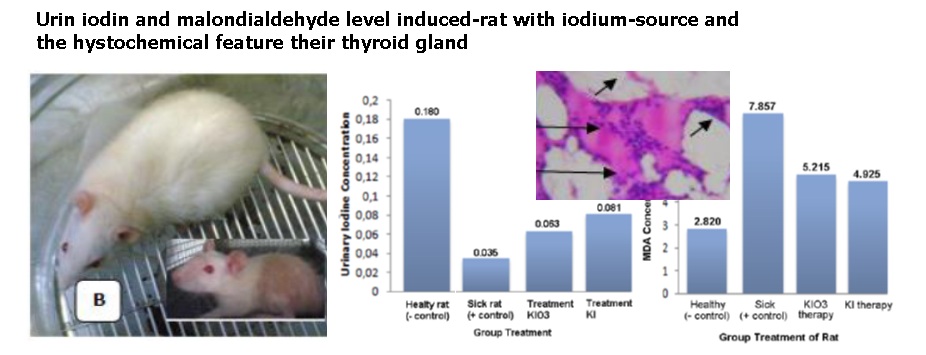The Effect of KIO3 and KI Salt Towards Iodium Levels (I2) in Urine, Malondialdehyde (MDA) and The Histology of Thyroid Gland of Goitrogenic Rat
Abstract

Goitrogenic substances can inhibit of iodine taking by the thyroid gland. Thus iodine concentration in thyroid gland will be low, and this phenomena is indicated by inflammation in the thyroid gland. Moreover, it can cause releaseing of an excessive amount of free radicals. This radicals, in the body, causes oxidative stress and also increase the levels of malondialdehyde (MDA). This is also as an indicator for lipid peroxidation and the decreasing of urinary iodine excretion levels (EIU). The treatment with KIO3and KI salt was intended to study the level of supplementation of iodine (I2) toward level of MDA in serum and histological description of rat’s thyroid gland. The MDA levels was determined through TBA test (Thio Barbituric Acid), meanwhile the histological pattern of rat thyroid gland was determined by Hematoxylen-Eosin staining (HE). The results indicated both of KIO3 and KI salt significantly (p<0.01) reduced MDA level in the serum. Treatment with KIO3 salt gave 33.62% while KI salt slightly higher (37,02%). In addition, both of treaments displayed an recovering effect in thyroid gland.
References
Masjhur, J. S., Indonesian Journal of IDD, 2002, 1 : 29 - 33 [2] Hetzel, B.S.. An Overview of the Prevention and Control of Iodine Deficiency Disorder; in Hetzel, J.T Dunn and J.B. Stanbury (ed)., 2005, Elvesier Science Publisher, New York. [3] Mulinda JR, 2005. Goiter. http://www.emedicine.com/MED/topic916.htm [4] World Health Organisation (WHO), Assesment of Iodine Deficiency Disorders and Monitoring Their Elimination. Second edition, 2001, WHO, New York. [5] Lang, K. Die Rhodanbildung im Tierkorper, Biochem Z., 1933, 259: 243-256. [6] O’Dell JR. New Engl. J. Med.,1999, 340, 310-312 [7] Deaney CL, Feyi K, Forrest CM, Freeman A, Harman G, McDonald MS, Petrie A, Shaw SJ, Stone TW, Stoy N, Darlington LG. Res. Comm. Mol. Pathol. Pharmacol. 2000, 110, 1-2, 87-95. [8] Bruch, C.G.and D.P Janet, AACN, 2002, 11, 543-551. [9] Burek, C.L., and N,R. Rose. Autoimmunity. 2008, 7, 540-537. [10] Burek C.L., and M.V. Talor., Autoimmunity, 2009, 33, 183-189.
Refbacks
- There are currently no refbacks.









